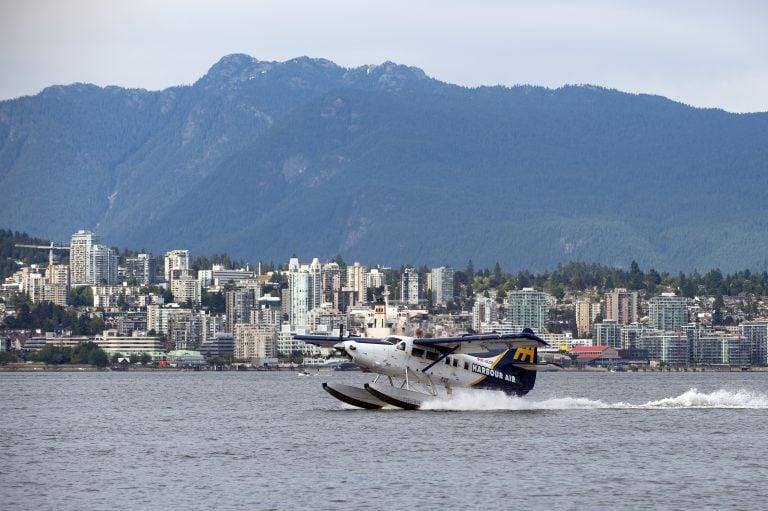Harbour Air: The airline on the path to an all-electric, zero-emission fleet
With regulatory approval, the world’s first ever commercial flight of an electric plane with paying customers could happen in 2021

A Harbour Air seaplane lands in Burrard Inlet in Vancouver, B.C., on June 25, 2019 (Photograph by Taehoon Kim)
Share
Greg McDougall has long been an early adopter of new technologies. When Tesla’s electric vehicles first came out, the founder and CEO of Harbour Air Ltd. was an early buyer. McDougall got a Model 3 for his wife and a Model S for himself. His car has Tesla’s infamous “Ludicrous Mode.” (If you dare touch the icon on the dashboard screen marked “Ludicrous,” then tap “Yes, bring it on” instead of “No, I want my mommy,” the four-door sedan turns into the fastest-accelerating production car in the world.)
Some may think that McDougall, 63, has hit Harbour Air’s “Bring it on” button. Already North America’s largest seaplane operator and an eight-time member of Deloitte’s list of Best Managed Companies, the firm now has a disruptive plan to dramatically change the world of aviation. If the Richmond, B.C.-based company succeeds, Harbour will be the world’s first airline to fly a completely electric fleet. It means converting all of its 40 seaplanes into—as the company puts it—ePlanes.
Back on March 19, Harbour announced it was partnering with magniX, a research and development company with operations in the U.S. and Australia. MagniX was set up in 2009 to develop high-power-density electric motors for the aviation industry, a sector where the last significant development in propulsion systems was the first jet-powered plane in 1939.
Using technology from magniX, Harbour is currently converting one of its 1960s-era vintage de Havilland DHC-2 Beaver float planes. It’s switching out the six-passenger Beaver’s gas engine with a much lighter electric motor. Fuel tanks will be removed from the wings and replaced with lithium-ion battery packs, also installed elsewhere in the fuselage. In what would be a historic step for aviation, the prototype plane could be flown for testing as early as November 2019. With regulatory approval, the world’s first ever commercial flight of an electric plane with paying customers could happen in 2021, and the conversion of the rest of Harbour’s fleet would start after that.
A pilot since 1974, McDougall founded Harbour Air in 1982. He started with two small seaplanes, ferrying log buyers up and down B.C.’s mountainous rainforest coast. The operation expanded quickly into tours, charters and eventually scheduled service. It now flies some 500,000 passengers from around the world on a dozen routes in the Pacific Northwest.
Some may be skeptical of Harbour’s plans to go electric. But McDougall’s been talking enthusiastically about it with many Harbour employees (as many as 500 during high season) and his aviation buddies for years. His early-adopter instincts told him the idea of electric-powered passenger airplanes is actually “a no-brainer.”
Road transportation is already being revolutionized by companies like Tesla. Aviation, though a bigger challenge, is a logical next step. Billions of dollars, explains McDougall, are already being spent on electric propulsion and battery research for the aviation industry by major companies like Boeing, Airbus and Bell Helicopter. “Some of the smartest people in the world are working on this.”
READ: How a premature move to electric trucks could hurt Canadian consumers
Aside from McDougall’s burning vision to go electric, Harbour Air’s mission was aided by the fact that about 70 per cent of its 30,000 flights each year are under 30 minutes, travelling from Vancouver to Victoria, Seattle and Whistler. These short-haul distances lie in the sweet spot for the current capabilities of electric propulsion systems.
Route lengths were one reason magniX knocked on Harbour Air’s door with an offer to pay the costs of converting Harbour’s Beaver prototype. But they were not the only reason. Harbour has long had a deep desire to reduce the carbon footprint of its operations—a drive that fits in well with a core purpose of magniX’s technology. In 2007, Harbour Air was the first North American airline to go 100 per cent carbon neutral, matching the impact of emissions with a carbon-offsetting program.
The decision says much about Harbour Air’s penchant for being an early adopter of ideas. It also, says Randy Wright, the company’s president, suggests something about their management style. Offsetting emissions to be greener was an idea that bubbled up from frontline staff, not the executives.
If one were to distill down McDougall’s management ethos, he says, it would be “surround yourself with amazing people.” Wright expands on that. Harbour carefully nurtures a culture of employee autonomy and camaraderie. “We are not sitting in the boardroom in an ivory tower,” says Wright, referring to the executives. “We are on the ground communicating with our personnel. What’s really cool about Greg is this is a family business still, even though we have investors.”
McDougall plans to himself pilot the test flight of the first battery-powered Beaver in November. And, he says, Harbour’s employees are “super excited” about the challenge to be the world’s first all-electric airline. But will Harbour’s passengers be as stoked?
There might be a fear factor for a few, he concedes. But for most of Harbour’s passengers, that will be quelled by education, as electric planes take wing and evolve. And, adds the early adopter: “The world is going to change, no matter what. You can’t put your finger in the dike” of technologies and developments such as Uber.
“If I have to take some arrows in my back to be the first to do this, that’s fine. I’m willing to do that to be first.”
This article appears in print in the August 2019 issue of Maclean’s magazine with the headline, “Electricity in the air.” Subscribe to the monthly print magazine here.